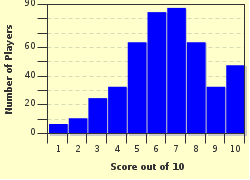Quiz Answer Key and Fun Facts
1. What process does a nuclear reactor use to produce energy?
2. A nuclear reactor produces what form of energy, which can then be used to generate electricity?
3. The first nuclear reactor was built during WWII, as part of the so-called "Manhattan Project." Where was the first reactor actually built?
4. In addition to building atomic weapons, the military soon found another use for nuclear power. On January 21, 1954 the United States launched the first nuclear-powered submarine. What was the name of this famous ship?
5. Nuclear power's other main use, outside of military applications, is generating electricity. The world's first nuclear power plant to produce electricity for civilian use was built in what country?
6. Although it is used in a few countries, nuclear power remains an insignificant factor in the worldwide production of electricity.
7. Some countries rely more upon nuclear power than others. In the first quarter of the twenty-first century, which country gets the highest percentage of its electricity from nuclear powered plants?
8. Nuclear power has a history of being a very safe source of energy, but no technology is perfect. One of the world's worst nuclear accidents occurred in 1986 in what present day country?
9. Nuclear power is cheap, generally safe, and the world's supply of nuclear fuel is plentiful. What is a major factor that has limited the expansion of nuclear power as a source of electricity?
10. Some countries have decided that the risks of nuclear power outweigh the advantages. Which of the following countries had no commercial nuclear reactors for producing electricity by 2010?
Source: Author
daver852
This quiz was reviewed by FunTrivia editor
crisw before going online.
Any errors found in FunTrivia content are routinely corrected through our feedback system.


